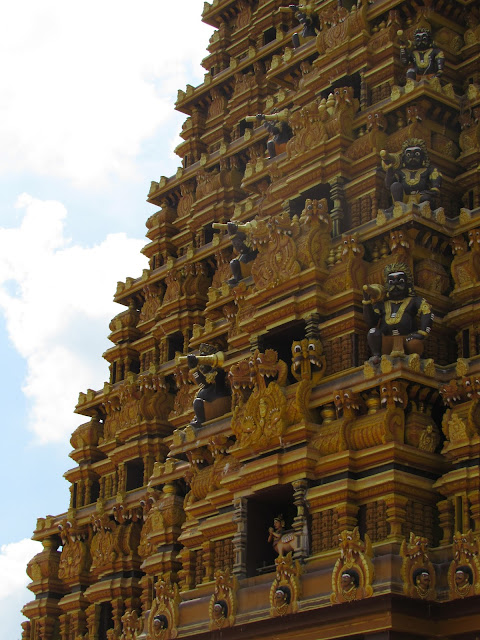On the train
As we travel North the water
disappears. When we leave Colombo at sunrise mist covers emerald
green rice patties, a delicate rose sky reflects in pools around the
crops. The air hangs heavy with water. Along the road to Jaffna the
water recedes, slowly at first, but suddenly you look up and palm
trees are replaced with stubby palms, and gnarled plants cling close
to sandy earth. A swamp devoid of water. I sit in the door of the
train and let the girtty air play across my face. Air is unfamiliar
without the clinging embrace of moisture – feel alien.
Money, too, drains like water from the
landscape. Houses cobbled together from sheet mettle, or half
finished with one wall painted or plastered and rest crumbling and
forgotten looking. We pass wells for the whole town, and NGOs
advertising their landmine clearing services. Though I know all this
is here, I am shocked to see it. My first tangible evidence of the
war. If in Colombo war hides in the shadows, here it covers the
landscape like dust. I lose count of the empty shells of houses we
pass.
Jaffna is a place of picturesque
destruction. From remnants of empire, to remnants of pre-war
prosperity, everything seems in ruins. Even the nicest streets are
pockmarked by lots empty except for collapsing concrete and the
occasional cow. I am torn: do I capture the crumbling beauty in my
camera, or turn away, leave the emptiness to the ghosts. How strange
to find the remains of destruction and violence beautiful.
Abandoned Churches
But our third day in Jaffna was one of
life. We went to the Nullar Kovil Temple for a Pooja, or worship
service. As we neared the temple we were greeted by a cacophony of
bells, which I thought must have come from a church, but realized
hung from one of the many great towers of the temple, looming in
great pyramids above the white sand and alive with carved demons and
grinning faces. As we drew close, the bells were replaced with drums
and the winding call of a horn. The priests, shirtless and striped in
holy ash, lead us with a crowd or worshipers from shrine to shrine
around the vast temple. The drummer hammered a beat that the horn
player wove in and out of while the priests opened door after door to
reveal the God hidden behind, and offer incense. The people around us
held up their hands or knelt in prayer as their favorite God was
revealed. As we circled around the temple the horn player began to
break away from the repetition of his song, soaring above and around
and then returning to his rhythms in a way I have only one word
for... it was Jazz.
A Buddhist monk
once told me that sees the world as infused with kindness. That
behind every object, machine, or place, is the kindness of hundreds
of people who helped to create it. Kindness of those who built the
building we stood in, kindness of those who made the carpets,
kindness of those who changed the lightbulbs and swept the floors. In
what we in the west call “self interest” and “profit motive”,
he sees a sacred network of interconnected individuals working to
help one another. I don't know if I can fully subscribe to this
kindness theory, but it is a worldview I like to fit over my own from
time to time, like tinted glasses. As I left, I realized, you can do
something similar for Jaffna. You can concentrate on the shells of
homes, mourn their emptiness, gnash your teeth at the slow pace of
reconstruction. But, for every abandoned house, there are a dozen
full ones. Jaffna was completely empty for years during the war. The
residents fled to squalid camps or hid and starved in jungles.
Everyone over the age of 12 remembers. But still, they come back.
Open shops. Rebuild their homes. Go on dates. Love. Fight. Mourn.
Have children. In Jaffna you can see tragedy in everything. Or, if
you choose, a world infused with hope.








As is true in many countries the Civil War in Sri Lanka was a war between religions. I think the native religion in the Jaffna area was not Buddhist historically but has been inserted by the majority population of Sri Lanka.
ReplyDelete